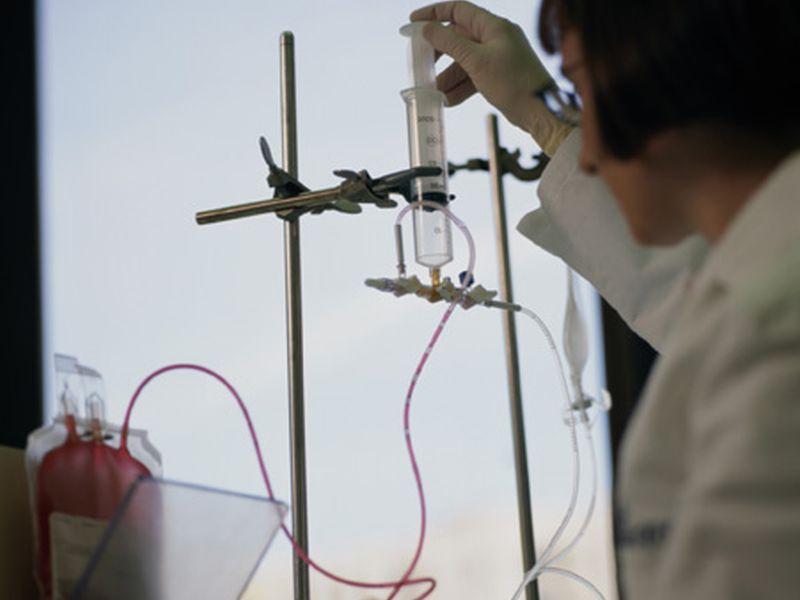
Wednesday, September 7, 2016

WEDNESDAY, Sept. 7, 2016 (HealthDay News) -- Bone marrow or stem cell transplants can save the lives of adults and children with leukemia, but an ideal donor often isn't available. In those cases, umbilical cord blood may work as well as current alternatives -- or even better in some cases, a new study suggests.
"Often, cord-blood transplant is thought to be only as the last resource for patients without donors. But cord blood does not have to be considered only an alternative donor source," said study lead author Dr. Filippo Milano.
"In centers with experience, it can yield to great outcomes," said Milano, an assistant member of the Clinical Research Division at Fred Hutchinson Cancer Research Center in Seattle.
At issue: How best to treat the blood cancer leukemia and a related condition called myelodysplastic syndrome? One approach replaces a patient's blood-producing bone marrow through a transplant. The "gold standard" is to find a relative who can donate bone marrow or stem cells, preferably a "matched" sibling whose blood is compatible with the patient's, Milano said. But for 70 percent of patients, this ideal fit doesn't occur, the study authors noted.
Physicians then might recommend a transplant from a compatible donor unrelated to the patient or an unrelated donor who's mostly (but not entirely) compatible.
This new study considers another option: A donation of cord blood from the placenta and umbilical cord of newborn babies. Like bone marrow or stem cell transplants, a cord-blood transplant can produce stem cells that create new blood.
"However, cord-blood donors and recipients don't need to be a perfect match," Milano said.
To compare the success of the different options, researchers looked at 582 patients with leukemia or myelodysplastic syndrome. If a compatible bone marrow or stem cell transplant from an unrelated donor wasn't available, the patients got either a cord-blood transplant or an incompatible bone marrow or stem cell transplant from an unrelated donor, Milano said.
"Our study showed that overall survival after cord-blood transplantation was comparable to the one observed after matched unrelated transplants," Milano said. And patients who got cord-blood transplants seemed to live longer than those who got non-matching bone marrow or stem cell transplants from unrelated donors, he noted.
The cord blood approach appeared especially beneficial for a subset of patients with what's known as "minimal residual disease." This means small amounts of cancer cells remained after the chemotherapy that is required before transplant.
"The risk of relapse is very high for them," Milano said. But "the risk of relapse was significantly lower in patients receiving cord-blood transplants," Milano said.
What about cost?
Milano said cord-blood transplants require more blood, potentially increasing the cost. But, he said, prices may drop thanks to technological advances that could allow less blood to be used.
Dr. Marcos de Lima, a bone marrow transplant specialist, said the study results are surprising.
"This validates the idea that cord blood is a very strong alternative to bone marrow as a source of stem cells for a transplant," said de Lima, a professor of medicine at Case Western Reserve University School of Medicine in Cleveland. Even so, "one would not go as far as saying cord blood should replace the fully matched donors," added de Lima, who wasn't involved in the study.
Another expert agreed.
Cord blood "is a very good option particularly in terms of high survival and low risks of relapse, and should be considered in a patient who does not have a fully matched family donor," said Dr. Vinod Prasad, who played no role in the study. He specializes in pediatric blood and marrow transplantation at Duke University Medical Center in Durham, N.C.
Questions remain, however, de Lima said. Why does cord blood seem better at vanquishing leftover cancer in some situations? It's not clear, he said. But it does seem that "cord blood is more tolerant of mismatches" between the donor and the patient who gets the transplant, he said.
The study was published in the Sept. 8 issue of the New England Journal of Medicine.
SOURCES: Filippo Milano, M.D., Ph.D., assistant member, clinical research division, Fred Hutchinson Cancer Research Center, and assistant professor, University of Washington, Seattle; Marcos de Lima, M.D., director, bone marrow transplant, University Hospitals Case Medical Center, and professor of medicine, Case Western Reserve University School of Medicine, Cleveland; Vinod Prasad, M.D., professor, pediatric blood and marrow transplantation, Duke University Medical Center, Durham, N.C.; Sept. 8, 2016, New England Journal of Medicine
HealthDay
Copyright (c) 2016 HealthDay. All rights reserved.
News stories are provided by HealthDay and do not reflect the views of MedlinePlus, the National Library of Medicine, the National Institutes of Health, the U.S. Department of Health and Human Services, or federal policy.
- More Health News on:
- Leukemia
- Stem Cells










































No hay comentarios:
Publicar un comentario